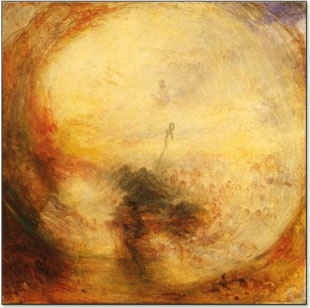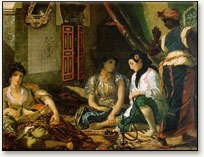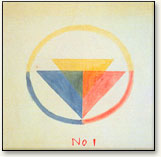JMW Turner, The Fighting Temeraire (1838). From the exhibition: Turner from the Tate: The Making of a Master Source: Supplied
JMW TURNER was a very quirky man, but he doesn't fit the cliche of angst-driven creative genius. He was ambitious, organised, financially savvy and an effective self-publicist. He raised himself up from the working class to a position of wealth and influence, admired by powerful friends. The only secret to painting, he said, was "damned hard work".
He was in constant dialogue with the past and he remained an Academician all his life, but he was also deeply individualistic, both socially and artistically. He broke step, creating a world view that was both idiosyncratically subjective and enduringly influential. In him, English romanticism reached its apogee in the visual arts.
Turner baffled and irritated the critics of his day as much as the French impressionists were to in the coming decades. Harrumphing descriptions such as "eggs and spinach" and "soap suds and whitewash" come down to us from contemporary assessments, especially of his later, more abstract work. Despite unshakeable self-belief, Turner himself admitted, "Atmosphere is my style and indistinctness my fault."
It would be after Turner's death that the revolutionary aspect of his landscapes and seascapes - their turbulence in mood and execution, evidence of Turner's desire to elevate them to the prestige of history painting - became more widely appreciated.
"The sun is God," he is said to have uttered on his deathbed. Whether that was a metaphysical or an aesthetic pronouncement is anyone's guess, but it does explain his sobriquet, the "painter of light". Turner experimented early with painting his oils on to a white ground, a technique he had already used in watercolours. Claude Monet and other French radicals, interested in breaking down light into its component parts, studied his technique, although they rejected the romantic notions of the sublime that suffused the older artist's work. The influence continues: one of the Art Gallery of NSW's finest acquisitions of recent years is Cy Twombly's 1998-99 triptych, a contemplative calligraphic riff on Turner's 1838 masterpiece, The Fighting Temeraire.
This week a large survey exhibition of Turner's work opens at the Art Gallery of South Australia, and will travel to the National Gallery of Australia in Canberra in June. Titled Turner from the Tate: The Making of a Master, it contains more than 100 paintings, watercolours and sketches, tracing his trajectory from boyhood to death.
Today, the Turner rooms at Tate Britain are always busy: even on a weekday many people mill about, and not all of them are students and tourists. In a 2005 BBC poll, people voted The Fighting Temeraire Britain's greatest painting. But it wasn't always so.
As Turner experimented with technique and his work became more abstract, his popularity faded even though his prestige remained. "So, I am to become a nonentity, am I?" he asked bitterly on his deathbed. He had been eclipsed by the hard-edged neoclassicism evolved by his contemporaries, the French history painters such as Jacques-Louis David and Jean-Auguste-Dominique Ingres. By the end of the 19th century, with the similarly hard-edged pre-Raphaelites all the rage in Britain and the impressionists not yet fully understood, Turner's bequest of more than 300 works of art to the nation languished in basement of the National Gallery, unappreciated.
When some of them were transferred to the Tate and put on show in 1906, it was a revelation. "By that stage, people had understood Monet," says Ian Warrell, who curated the Adelaide show, standing before one of Turner's masterpieces at the Tate. "It took British art collectors a long time to assimilate the impressionists. When they saw this thing, they thought, 'Oh, Turner got there first!"
It was not until the American abstract expressionists returned large-scale gesture and emotion to the visual arts repertoire, some say, and drew the art world's gaze away from continental Europe, that Turner's fortunes revived. In 1987, a dedicated wing, the Clore Gallery, was opened at Tate Britain to showcase his work.
The museum has demonstrated the artist's place in history with a series of thematic exhibitions in recent years, some of which juxtapose his work with other painters, some of which have travelled abroad. The biggest Turner show in Australia before this one, however, was held in Canberra in 1996: it was organised around the artist's works in Australian collections by Michael Lloyd, the widely admired curator who was already suffering from the cancer that would soon claim him, and works from the Tate were not prominent.
John Mallord William Turner was born in Covent Garden in 1775, the son of a barber and a butcher's daughter. His childhood was difficult: a younger sister died when she was four, his mother went mad, dying eventually in Bedlam, and he was farmed out to relatives.
His father had such faith in his boy's artistic abilities, however, that he displayed the juvenile Turner's sketches for sale in his shop window, attracting the notice of people who would help the precocious child's career. Turner was 14 when he enrolled in the Royal Academy of Art school, barely 15 when his first watercolour was displayed there.
He seemed to want to be an architect, and his early subjects reflect that, but one of his mentors, the architect Thomas Hardwick, advised him to concentrate on painting. He was 24 when he became an associate of the Royal Academy, and three years later became its youngest ever member.
His meteoric rise opened the doors of the aristocracy, who were keen to commission him and who also gave him access to art collections at a time when public museums did not exist. The milieu did nothing to smooth his rough edges.
In the catalogue of a Turner exhibition that toured the US in 2007 and 2008, which Warrell also curated, he wrote that Turner went out of his way to appear cryptic and to confound straightforward interpretations of his art. "His was a personality that somehow embraced diametrically opposed absolutes: he encompassed the need to pursue radical, independent ends, while maintaining his allegiance to the presiding academic institutions; he presented imagined realities as vividly as if they were documentary reportage; and he opened up dynamic new avenues of subject and style, while also imitating and celebrating the best of the past," he wrote.
Not the least oppositional about the artist was that, although his aesthetic imagination was prodigious, his manner was abrasive. He was stocky and sloppy in his clothes and grooming. His address was direct and unceremonious. He was curmudgeonly, though a loyal and supportive friend to colleagues. He was also intensely independent and secretive about his personal life. Although he lived with his father for 30 years, until the older man died after decades of acting as his famous son's factotum, Turner also found time for romantic liaisons - including with an older widow, Sarah Danby, whose two children, born 10 years apart, are believed to be his; and with Sophia Booth, in whose household he died.
In his early years as a practising artist, Turner travelled widely in Britain in search of subject matter. He was already fired by the work of the French painter Claude Lorrain - he would come to be called "the British Claude" - and, like all artists, looked to Italy for inspiration, but the Napoleonic wars prevented him seeing the continent for himself until he was nearly 30. Claude's work was well represented in British collections and Turner was able to study it without leaving home, but his understanding of its subject matter was secondhand. His domestic travels gave a particularly English sensibility even to those works that emulated the classical monument-strewn grandeur of earlier French and Italian landscape painters.
When he was finally able to cross the Channel, during a hiatus in the Napoleonic wars in 1802, he travelled in the Swiss Alps and studied in the Louvre, then filled with paintings Napoleon had looted from across Europe. He finally made it to Italy in 1818, after years of immersion in classical literature, and found the landscape not at all what he had expected from minute observation of Claude's idealised classicism. He sketched madly, absorbing both the southern light and the contemporary realities of the country.
"Once he's been to Italy, his colour and form are transformed," says Warrell. "It's more Turner as we know him."
On his return, he worked up several large-scale paintings, including the famous Rome, from the Vatican. Raffaelle, Accompanied by La Fornarina, Preparing his Pictures for the Decoration of the Loggia, which is coming to Australia. His Italy was no longer imaginary, based on others' interpretations. His own observations allowed him a different kind of imaginary: the juxtaposition of concrete details with flights of thematic pastiche, which would have been instantly recognisable to an educated public, steeped in the writing of Ovid and Edward Gibbon.
In 1828, Turner returned to Italy for a longer stay, traversing the Alps again and reaching Rome and Naples via Venice, Bologna and Rimini. He exhibited at the Quirinale, framing his paintings with ship's rope painted his favourite colour, yellow, instead of with wood. Italian critics were even more severe than the British. They compared him with another Englishman, a tradesman of the same name living in Rome at the same time: one sold mustard, they said, the other painted it. Another critic put it in even less flattering terms, suggesting he had crapped rather than painted on his canvas.
By this time, his love of yellow was one of two signature aspects of Turner's work; the other was his engagement with the sublime. Until the turbulence of romanticism, depictions of landscape were sedate celebrations of man's mastery over nature. People were shown in the various labours of farming; the countryside was tamed. Later, the beauty of nature itself was appreciated, unspoiled and uplifting: God's gift to humanity.
British philosopher Edmund Burke named the progression of aesthetic treatments of nature as the pastoral, the picturesque and, finally, the sublime. In the sublime, perhaps most famously conjured by the German artist Caspar David Friedrich, nature is awe-inspiringly majestic, alternatively terrifying and ineffable, reducing human beings to puniness.
Turner's sublime elements, his seas and stormy skies, were particularly wild and the intensity of their making remains in the marks on paper or canvas. "He began by pouring wet paint till it was saturated," said a fellow house guest at a country house, who watched him work on a watercolour, A First Rate Taking in Stores, in 1818, "he tore, he scratched, he scrubbed at it in a kind of frenzy and the whole thing was chaos - but gradually and as if by magic the lovely ship, with all its exquisite minutiae, came into being and by luncheon time the drawing was taken down in triumph."
In his earlier works, humans struggle valiantly and centrally against the elements. As the years pass, his human figures diminish, until they are often barely decipherable on the margins of elemental activity. Disaster at Sea, also known as The Wreck of the Amphitrite, was painted between 1833 and 1835, in the wake of the shipwreck of a convict vessel bound for Botany Bay. All 125 women and children on board were lost in a violent storm off the coast of France, and a later inquiry established that the captain had not lowered his lifeboats and had refused help from the French coastguard, claiming he was not authorised to land his cargo until its destination. The ship is barely decipherable among Turner's billowing waves and cloud, a roiling mass of whites and ochres and steely blues.
Turner was almost journalistic in the way he seized current events for subject matter. And he was a master of spin. Warrell points to another, earlier work coming to Australia, called Spithead: Two Captured Danish Ships Entering Portsmouth Harbour. "During the Napoleonic wars, the Danes had looked as though they were going to join up with the Russians and the French against us, so as a pre-emptive exercise the English started bombing Copenhagen and actually flattened it. It was unmerciful," Warrell says. "By the time Turner painted this, attitudes had gone from being triumphalist to being rather embarrassed. The original title was Two Captured Danish Ships, then he changed it to 'Boat's crew recovering an anchor'. So topicality could have its downside."
The politically diplomatic name for the work - it is coming to Australia under the original - pits humanity against the heaving sea in way that is actually more emblematic of Turner's worldview. As English critic Laura Cumming described it, a propos the Turner-Claude exhibition last year, "pick any decade of his maturity and you see land treated as if it were air and as if it were water".
The insubstantiality he himself rued at times became his calling card. Like the later impressionists, but for entirely different reasons, he dissolved linear outlines and focused on colour. For the impressionists, it was about breaking down optical illusion created by light on the retina. Turner was grasping for the sublime through the numinous and, towards the end, as his work became more abstract, viewers were increasingly at a loss.
Some controversy surrounds the more minimalist pictures, however. Are the ones we revere today for their prescient abstraction finished? "The degree of finish is something people still find uncertain," Warrell admits.
Turner was pragmatic. He would often not finish a painting until a buyer had shown definite interest. He was a showman and would sometimes use the time allowed for painters to put finishing touches to pictures, once they saw how they looked on the walls of Royal Academy, to transform a work from a glorified sketch into a bravura finished painting in front of visitors' eyes. Many of the works that were left to the nation languished because scholars thought them unfinished.
"That's what a lot of Turner scholars think, but we don't actually know," Warrell says. "He wasn't very good at writing things down, there are no diaries, there are sketch books. He was just so busy absorbing or painting he didn't have time for that kind of record."
Turner from the Tate: The Making of a Master, at the Art Gallery of South Australia from February 8 until May 19, and at the National Gallery of Australia, Canberra, from June 1 until September 8.
Miriam Cosic travelled to London with the partial assistance of Art Exhibitions Australia.










